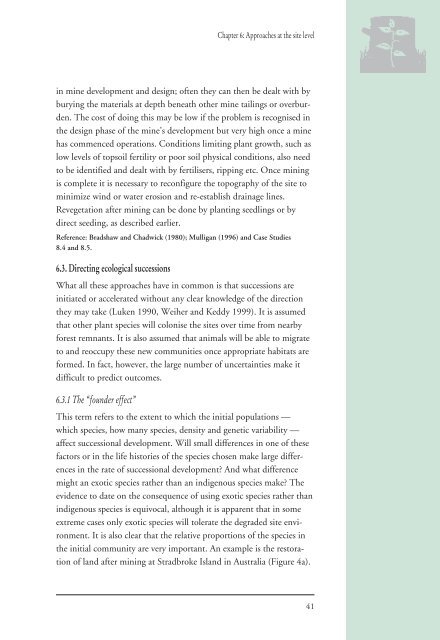Rehabilitation and Restoration Of Degraded Forests (PDF) - IUCN
Rehabilitation and Restoration Of Degraded Forests (PDF) - IUCN
Rehabilitation and Restoration Of Degraded Forests (PDF) - IUCN
You also want an ePaper? Increase the reach of your titles
YUMPU automatically turns print PDFs into web optimized ePapers that Google loves.
Chapter 6: Approaches at the site level<br />
in mine development <strong>and</strong> design; often they can then be dealt with by<br />
burying the materials at depth beneath other mine tailings or overburden.<br />
The cost of doing this may be low if the problem is recognised in<br />
the design phase of the mine’s development but very high once a mine<br />
has commenced operations. Conditions limiting plant growth, such as<br />
low levels of topsoil fertility or poor soil physical conditions, also need<br />
to be identified <strong>and</strong> dealt with by fertilisers, ripping etc. Once mining<br />
is complete it is necessary to reconfigure the topography of the site to<br />
minimize wind or water erosion <strong>and</strong> re-establish drainage lines.<br />
Revegetation after mining can be done by planting seedlings or by<br />
direct seeding, as described earlier.<br />
Reference: Bradshaw <strong>and</strong> Chadwick (1980); Mulligan (1996) <strong>and</strong> Case Studies<br />
8.4 <strong>and</strong> 8.5.<br />
6.3. Directing ecological successions<br />
What all these approaches have in common is that successions are<br />
initiated or accelerated without any clear knowledge of the direction<br />
they may take (Luken 1990, Weiher <strong>and</strong> Keddy 1999). It is assumed<br />
that other plant species will colonise the sites over time from nearby<br />
forest remnants. It is also assumed that animals will be able to migrate<br />
to <strong>and</strong> reoccupy these new communities once appropriate habitats are<br />
formed. In fact, however, the large number of uncertainties make it<br />
difficult to predict outcomes.<br />
6.3.1 The “founder effect”<br />
This term refers to the extent to which the initial populations —<br />
which species, how many species, density <strong>and</strong> genetic variability —<br />
affect successional development. Will small differences in one of these<br />
factors or in the life histories of the species chosen make large differences<br />
in the rate of successional development? And what difference<br />
might an exotic species rather than an indigenous species make? The<br />
evidence to date on the consequence of using exotic species rather than<br />
indigenous species is equivocal, although it is apparent that in some<br />
extreme cases only exotic species will tolerate the degraded site environment.<br />
It is also clear that the relative proportions of the species in<br />
the initial community are very important. An example is the restoration<br />
of l<strong>and</strong> after mining at Stradbroke Isl<strong>and</strong> in Australia (Figure 4a).<br />
41

















